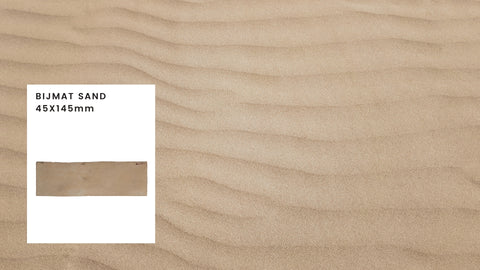The art of Zellij has been used for hundreds of years to decorate homes as a statement of luxury and sophistication. Formed by hand, the base tile is dried in the Moroccan sun until it contains less than 10% moisture. It is then dip glazed by hand and fired in a ‘beehive’ kiln, a unique, traditional kiln fired by woodchip and sawdust. This process has not changed for centuries, and results in a myriad of slight imperfections in the glaze and tile surface from which Zellij has garnered a characteristic notoriety and cult design following.
The unique Moorish art form has been reimagined to reflect colours inspired by Australian landscapes, from the deep yellow sands of the Nullarbor plains to the rich green shades of coastal rock pools. Named after Australian flora and landscapes, these handmade tiles feature characteristics that give each individual tile personality.
Pampas grass is a perennial grass common in New South Wales, in particular the Central Coast and the Central Tablelands. It is however an environmental weed, currently under strict control measures. Zellij Pampas and Bijmat Pampas features soft, wispy shades of white glaze, in some places transparent allowing the earthy pink tones of the tile biscuit to show through - like light filtering through the foliage of wild pampas grass.

Nullarbor is a flat, vast plain in South Australia with a desert climate. This arid landscape is rich in limestone and is known for the sand’s iconic golden tones. Zellij Nullarbor was named after this incredible stretch, as the glaze features a burnt earth colour with sandy tones.

Eucalyptus trees are native to Australia and are widely used for their medicinal properties. Vibrant, pollen-filled flowers and their aromatic evergreen leaves feed many Australian fauna. Tiny gumnuts are commonly found vigorously scattered throughout the bush floor. Zellij Eucalypt features an iconic shade of green that populates the bushland, with its imperfect glaze mirroring the rugged Australian scrub.

As the sun sets over the coasts of Australia, the tide slowly washes out over the sand. Waters reflect a dimming blue sky ribboned with accents of pink - a scene well-known by many Australians. Zellij Low Tide reflects this in its dull blue glaze that shows areas of the sandy tile biscuit, featuring the subtle pink tones of a sunset tide.

Australia’s landscapes boast natural wonders including vast salt lakes, creviced from the harsh Australian climate. These large salt pans are caused by filling with seawater and evaporation, leaving behind beds of salt. Zellij Salt Lake presents a stark white glaze, similar to the glaring ivory of salt lakes.

Named after the iconic Whitsundays beach, Zellij Whitehaven is parallel to the island’s milky shore. Its ivory glaze is slightly transparent to reveal the sandy tones of the biscuit underneath, imitating the warmth of the sand and its ripples.

Paperbark trees are native to Australia and are known for their soft, flaky bark. Its bark can be used as a bandage or to wrap food. The paperbark peels off to reveal layers of cream, grey and beige. Zellij Paperbark displays this variation in shades through its slight transparency, revealing earthy tones underneath a soft, neutral glaze.

The Smoke Bush is a small tree that is named after its fluffy flower heads. Typically blush pink to plum, these flowers resemble clouds of smoke. Zellij Smoke Bush was named after its pale pink hue, similar to the soft blossoms of the Smoke Bush.

A nostalgic name for many Australians who grew up searching for tiny fish, sea snails and critters inhabiting the rockpools of our coastline. These pools are abundant in life, evident in the many shades of green that hide below the water. Zellij Rockpool displays the variations in green, ranging from a rich algae green to a paler shade with hints of earth brown. Its hand-dipped glaze features tiny bubbles and bumps, mirroring the rockpool surface that hides and homes many living organisms.

Yabbies are freshwater crustaceans native to Australia. They inhabit shallow waters and hide amongst vegetation and structures. Many Australians spent their childhoods catching yabbies in creeks found in bushland. The glaze of Zellij Yabby is inspired by the flashes of intense red that come from the Red Claw Yabby, commonly found in the rivers of the Northern Territory.

The Bass Strait is the sea that separates Tasmania from the rest of Australia and is home to over 50 islands. Prevailing winds and unpredictable currents have sparked numerous myths and legends about this sea’s history. Renowned for its treacherous nature, Zellij Bass Strait inherited its name from the menacing blue depths that are reflected in its deep blue glaze.

Australia is distinguished by its harsh climate. Much of our lands are prone to bushfires, often spreading quickly and incinerating anything in its path. However this has developed a quality of resilience, so our hardy environment is able to regrow the flora that once inhabited the land. Zellij Scorched Earth features a deep charcoal that represents our burnt country, but serves as a reminder of the toughness of Australian terrain.

The unglazed, natural finish of Bijmat Sand highlights its personality and handmade nature. Each tile is completely unique, varying slightly in colour and featuring small bumps and chips that were formed through its creation process in Morocco.
Click here to view the Zellij collection, or here to view the Bijmat collection.

